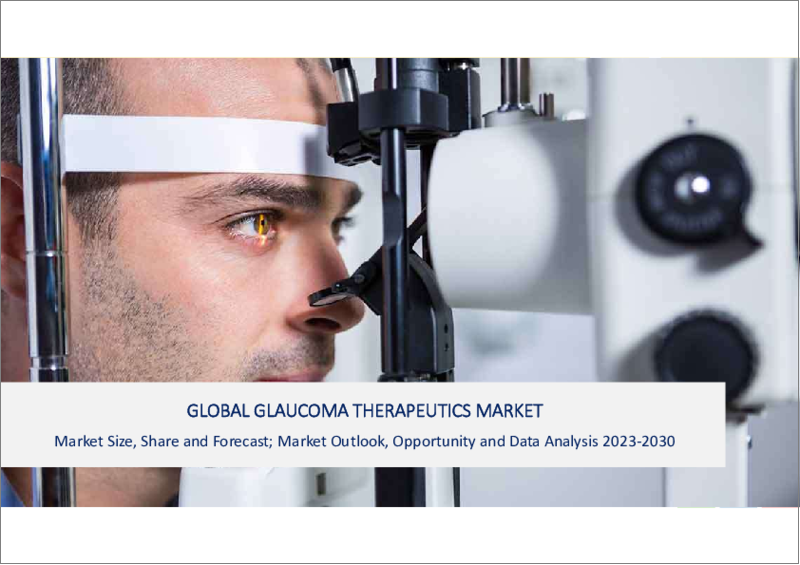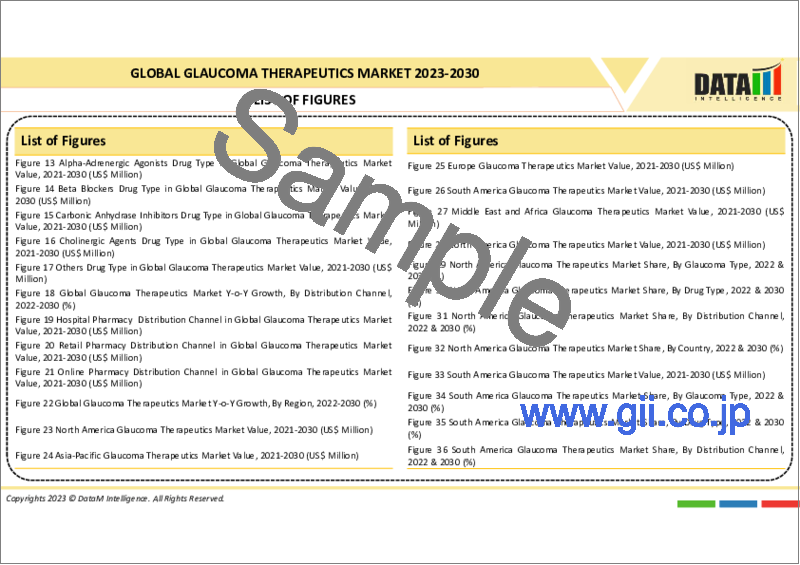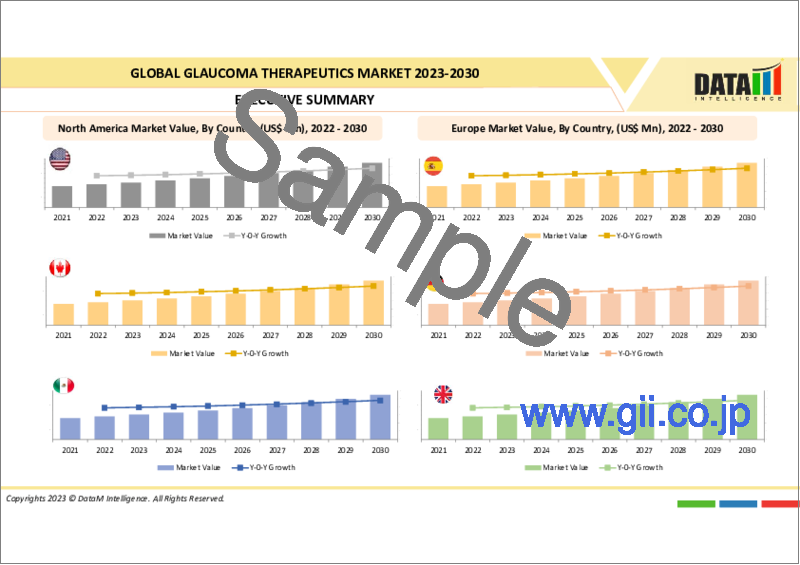|
|
市場調査レポート
商品コード
1297830
緑内障治療薬の世界市場-2023年~2030年Global Glaucoma Therapeutics Market - 2023-2030 |
||||||
カスタマイズ可能
適宜更新あり
|
|||||||
| 緑内障治療薬の世界市場-2023年~2030年 |
|
出版日: 2023年06月15日
発行: DataM Intelligence
ページ情報: 英文 195 Pages
納期: 即日から翌営業日
|
- 全表示
- 概要
- 目次
市場概要
世界の緑内障治療薬市場は、2022年に61億米ドルに達し、2030年には93億米ドルに達するなど、有利な成長が予測されています。世界の緑内障治療薬市場は、予測期間(2023~2030年)にCAGR 5.7%を示すと予測されています。技術的進歩の増加や新規製品の臨床試験の増加が、緑内障治療薬市場の動向の需要を押し上げています。
革新的なドラッグデリバリーシステムの開拓、新薬の組み合わせの発売、緑内障患者の増加は、緑内障治療薬の世界市場を推進する主な要因です。
緑内障治療薬市場の範囲は、開放隅角緑内障、閉塞隅角緑内障、先天性緑内障、続発性緑内障などの緑内障タイプで構成され、緑内障治療薬市場シェアを拡大しています。緑内障治療薬の世界市場は、研究開発の増加や各国での今後の新規製品承認などの要因の結果として拡大しており、緑内障治療薬市場の成長にも明るい見通しを生み出しています。
市場力学
主要企業別臨床試験の増加が緑内障治療薬市場の成長を牽引
過去30年間で、緑内障研究のための臨床試験の数は大幅に増加しています。緑内障治療を改善するため、世界的に多くの研究が行われています。その中でも外科的、薬物的、行動的介入を検討する臨床試験は特に興味をそそられます。臨床試験は、特定の治療法を試験し、特定の薬剤の適切な投与量を決定し、治療法の悪影響を評価する4つの段階にわたって進行します。
最近評価された物質の中には、3つの主要な治療様式がすべて含まれていたが、血管や神経保護様式に関する臨床試験はまだほとんどないです。従来の薬物療法に加えて、栄養補助食品や成長ホルモンの抗緑内障作用の可能性が研究されています。
すべての疾患および眼科一般について、第II相および第III相の成功率は、以前に発表された成功率よりも低かっています。緑内障や眼科の研究では、個人の表現型をより厳格にすることで成功率を高め、研究者が反応者と非反応者を識別するのに役立つ。
研究開発と新製品上市の増加がメーカーに有利な機会をもたらす
多くの研究者やフェローによる臨床研究や基礎科学研究への貢献は、新規治療法の開発を加速させ、疾患の起源や経過に関する理解を著しく向上させています。いくつかの臨床試験が実施され、良好な結果が得られています。
緑内障治療薬市場の成長には、新製品の上市や規制当局の承認の増加が重要な促進要因となっています。例えば、2022年9月22日、原発性開放隅角緑内障または高眼圧症の患者における過度の眼圧下降を目的としたOmlonti 0.002%点眼薬のFDA承認がSantenとUBEによって発表されました。
オムロンティの有効成分であるオミデネパグイソプロピルは、この特異な薬理作用を有する唯一の薬剤です。プロスタグランジンEP2受容体アゴニストであり、従来の流出経路およびぶどう膜強膜流出経路を介した房水排出を増加させる。
薬剤に関連する副作用が市場の成長を妨げる
緑内障治療薬の潜在的な副作用は多岐にわたる。目の色の変化、まぶたの皮膚の黒ずみ、まつ毛の成長、くぼみ目、眼瞼下垂、しみる、充血、かゆみなどはすべてプロスタグランジン類似薬の徴候です。β遮断薬は時に、血圧低下、心拍低下、倦怠感、息切れを引き起こします。ごくまれに、うつ病や性欲減退を引き起こすこともあります。
灼熱感やしみるような痛み、疲労感、頭痛、眠気、口の渇き、鼻の乾燥、アレルギー反応を起こす可能性がかなり高くなることなどは、すべてα作動薬の影響です。錠剤として使用される場合、炭酸脱水酵素阻害薬は手足のしびれ、倦怠感、胃のトラブル、記憶力の問題、頻尿を引き起こす可能性があります。点眼剤では、しみるような痛み、灼熱感、眼痛が生じる。
COVID-19影響分析
COVID-19のパンデミックと世界各国での封鎖により、あらゆる業種の企業の財務の健全性が影響を受けています。そのため米国食品医薬品局(FDA)は、COVID-19の健康上の緊急事態の間隔を考慮し、スポンサーと研究者を支援するための一般的な考慮事項を含むガイドラインを発行し、試験参加者の安全性を確保し、適正臨床実施(GCP)を遵守し、試験の完全性に対するリスクを最小限に抑えました。
ロシア・ウクライナ紛争の影響分析
ロシア・ウクライナ紛争は、この地域の主要市場プレイヤーの数が少ないため、世界の緑内障治療薬市場に与える影響は低いと推定されます。しかし、原材料の輸出入の影響は、予測期間中、世界の緑内障治療薬市場の成長にほとんど影響を与えないと予想されます。
目次
第1章 調査手法と調査範囲
第2章 定義と概要
第3章 エグゼクティブサマリー
第4章 市場力学
- 影響要因
- 促進要因
- 主要企業による臨床試験の増加
- 政府の支援とイニシアチブの増加
- 抑制要因
- 医薬品に関連する副作用
- 機会
- 研究開発と新製品の上市の増加
- 影響分析
- 促進要因
第5章 産業分析
- ポーターの5フォース分析
- サプライチェーン分析
- 価格分析
- 規制分析
第6章 COVID-19分析
第7章 緑内障タイプ別
- 開放隅角緑内障
- 閉塞隅角緑内障
- 先天性緑内障
- 続発緑内障
第8章 薬剤別
- プロスタグランジン
- キサラタン(ラタノプロスト)
- トラバタンZ(トラボプロスト)
- ジオプタン(タフルプロスト)
- ルミガン(ビマトプロスト)
- αアドレナリン作動薬
- β遮断薬
- 炭酸脱水酵素阻害薬
- コリン作動薬
- その他
第9章 流通チャネル別
- 病院薬局
- 小売薬局
- オンライン薬局
- その他
第10章 地域別
- 北米
- 米国
- カナダ
- メキシコ
- 欧州
- ドイツ
- 英国
- フランス
- スペイン
- イタリア
- その他欧州
- 南米
- ブラジル
- アルゼンチン
- その他南米
- アジア太平洋
- 中国
- インド
- 日本
- オーストラリア
- その他アジア太平洋地域
- 中東・アフリカ
第11章 競合情勢
- 競合シナリオ
- 市況/シェア分析
- M&A分析
第12章 企業プロファイル
- Merck & Co., Inc.
- 会社概要
- 製品ポートフォリオと説明
- 財務概要
- 主な発展
- Pfizer Inc.
- AbbVie Inc.
- Alcon
- Bausch & Lomb
- Novartis AG
- Inotek Pharmaceuticals
- Sun Pharmaceutical Industries Ltd.
- Astellas Pharma Inc.
- Vivavision Biotech Ltd.
第13章 付録
Market Overview
The Global Glaucoma Therapeutics Market reached US$ 6.1 billion in 2022 and is projected to witness lucrative growth by reaching up to US$ 9.3 billion by 2030. The global glaucoma therapeutics market is expected to exhibit a CAGR of 5.7% during the forecast period (2023-2030). The increasing technological advancements and the growing clinical trials for novel products are driving up demand for glaucoma therapeutics market trends.
The development of innovative drug delivery systems, the launch of new drug combinations, and an increase in patients with glaucoma are the main factors propelling the global market for glaucoma therapeutics.
The glaucoma therapeutics market scope comprises glaucoma type as open angle glaucoma, angle-closure glaucoma, congenital glaucoma and secondary glaucoma, which has increased the glaucoma therapeutics market share. The global market for glaucoma therapeutic is expanding as a result of factors including increasing research and development and their upcoming novel product approvals across countries are also creating a positive outlook for the glaucoma therapeutics market growth.
Market Dynamics
The Rising Clinical Trials by Key Companies Drive the Growth of the Glaucoma Therapeutics Market
Over the past 30 years, there has been a considerable increase in the number of clinical studies for glaucoma research. In order to improve glaucoma treatment, numerous studies are being carried out globally to study the illness. Clinical trials examining either surgical, medicinal, or behavioral intervention are particularly intriguing among these. Clinical trials progress over four phases that test a specific treatment, determine the right dosage of a certain drug, and assess the treatment's negative effects.
All three major treatment modalities were present among the most recently assessed substances, but there are still few clinical trials in vascular and neuroprotection modalities. In addition to conventional medications, the possible anti-glaucomatous effects of nutritional supplements and growth hormones are investigated.
For all disorders and ophthalmology in general, phase II and phase III success rates were lower than previously stated success rates. In glaucoma or ophthalmological research, stricter phenotyping for individuals can increase success rates and help researchers identify responders and non-responders.
Rising Research and Development and Novel Product Launches Creates Lucrative Opportunities for Manufacturers
Contributions to clinical research and fundamental science research from a number of researchers or fellows have accelerated the development of novel treatments and significantly improved our understanding of the origins and course of disorders. Several clinical trials are being conducted resulting in positive outcomes.
The rising novel product launches and regulatory approvals are the key driving factors for the growth of the glaucoma therapeutics market. For instance, on September 22, 2022, FDA approval of Omlonti 0.002% eye drops for lowering excessive IOP in people with primary open-angle glaucoma or ocular hypertension was announced by Santen and UBE.
Omlonti's active pharmaceutical ingredient, omidenepag isopropyl, is the only medication with this specific pharmacological action. It is a prostaglandin EP2 receptor agonist that increases aqueous humor drainage through the traditional and uveoscleral outflow pathways.
Side Effects Linked with Drugs Will Hamper the Growth of the Market
The potential adverse effects of glaucoma medicines are varied. Eye color changes, eyelid skin darkening, eyelash growth, sunken eyes, droopy eyelids, stinging, redness, and itching are all signs of prostaglandin analogues. Beta blockers occasionally cause slow blood pressure, a slower heartbeat, weariness, and shortness of breath; very rarely, they also cause depression and a decreased libido.
Burning or stinging, exhaustion, headaches, drowsiness, dry mouth, dry nose, and a substantially greater chance of allergic reaction are all possible effects of alpha agonists. When used as pills, carbonic anhydrase inhibitors can induce tingling in the hands and feet, weariness, stomach trouble, memory issues, and frequent urination. Eye drop form produces stinging, burning, and eye pain.
COVID-19 Impact Analysis
The financial health of companies across all industries has been impacted by the COVID-19 pandemic and lockdown in numerous nations throughout the world. Therefore, for the interval of the COVID-19 health emergency, the U.S. Food and Drug Administration (FDA) issued guidelines that include general considerations to aid sponsors and researchers, ensuring the safety of trial participants, adhering to good clinical practice (GCP), and minimizing risks to trial integrity.
Russia-Ukraine War Impact Analysis
The Russia-Ukraine conflict is estimated to have a low impact on the global glaucoma therapeutic market, owing to the low number of key market players in this region. However, the impact of the import and export of raw materials is expected to have little influence over the global glaucoma therapeutics market growth over the forecast period.
Segment Analysis
The global glaucoma therapeutics market is segmented based on glaucoma type, drug type, distribution channel and region.
Prostaglandins from Drug Type Segment Account for 36.7% of the Market Share Owing to Rising Utilization
Prescription eye drops are the most typical form of treatment for glaucoma. These work by lowering intraocular pressure and safeguarding the optic nerve. These eye drops won't restore vision loss or treat glaucoma, but they can prevent it from growing worse.
To treat glaucoma, a variety of medications are available. Xalatan (latanoprost), Travatan Z (travoprost), Lumigan (bimatoprost), Zioptan (tafluprost), and Vyzulta (latanoprostene bunod) are examples of prostaglandin analogs that operate by enhancing the outflow of fluid from the eye.
Due to their effectiveness, once-daily dose, and minimal side effect profile, prostaglandin analogs (PGAs) are considered the cornerstone of glaucoma treatment. All surgical and medicinal glaucoma treatments have as their primary goal lowering intraocular pressure (IOP), which is now the only adjustable component.
Geographical Analysis
North America Accounted for Approximately 39.9% of the Market Share Owing to the Strong Presence of Major Players and Rising Technological Advancements
Manufacturers have chances to expand their operations in this region because of the rising demand for glaucoma therapeutic advancements in North America. The area has many producers and suppliers, and its rapid economic development has raised industrial production of glaucoma therapeutic, which has increased the demand. There are many manufacturers and suppliers in North America, and as a result of the region's rapid economic growth, industrial production has expanded.
Rising technological developments, governmental approvals, and the introduction of new products all contribute to growth. People are becoming more aware of novel technologies and disorders related to the eye sight, leading to the expansion of the market in this region. These factors shows the dominance of North America.
Competitive Landscape
The major global players in the glaucoma therapeutics market include: Merck & Co., Inc., AbbVie Inc., Pfizer Inc., Alcon, Novartis AG, Bausch & Lomb, Inotek Pharmaceuticals, Astellas Pharma Inc., Sun Pharmaceutical Industries Ltd. and Vivavision Biotech Ltd. among others.
Why Purchase the Report?
- To visualize the global glaucoma therapeutics market segmentation based on glaucoma type, drug type, distribution channel and region, as well as understand key commercial assets and players.
- Identify commercial opportunities by analyzing trends and co-development.
- Excel data sheet with numerous data points of glaucoma therapeutics market level with all segments.
- PDF report consists of a comprehensive analysis after exhaustive qualitative interviews and an in-depth study.
- Product mapping available as Excel consisting of key products of all the major players.
The global glaucoma therapeutics market report would provide approximately 53 tables, 54 figures and 195 Pages.
Target Audience 2023
- Manufacturers/ Buyers
- Industry Investors/Investment Bankers
- Research Professionals
- Emerging Companies
Table of Contents
1. Methodology and Scope
- 1.1. Research Methodology
- 1.2. Research Objective and Scope of the Report
2. Definition and Overview
3. Executive Summary
- 3.1. Snippet by Glaucoma Type
- 3.2. Snippet by Drug Type
- 3.3. Snippet by Distribution Channel
- 3.4. Snippet by Region
4. Dynamics
- 4.1. Impacting Factors
- 4.1.1. Drivers
- 4.1.1.1. The Rising Clinical Trials by Key Companies
- 4.1.1.2. Increased Government Support and Initiatives
- 4.1.2. Restraints
- 4.1.2.1. Side Effects Linked with Drugs
- 4.1.3. Opportunity
- 4.1.3.1. Rising Research and Development and Novel Product Launches
- 4.1.4. Impact Analysis
- 4.1.1. Drivers
5. Industry Analysis
- 5.1. Porter's 5 Forces Analysis
- 5.2. Supply Chain Analysis
- 5.3. Pricing Analysis
- 5.4. Regulatory Analysis
6. COVID-19 Analysis
- 6.1. Analysis of COVID-19
- 6.1.1. Scenario Before COVID-19
- 6.1.2. Scenario During COVID-19
- 6.1.3. Scenario Post COVID-19
- 6.2. Pricing Dynamics Amid COVID-19
- 6.3. Demand-Supply Spectrum
- 6.4. Government Initiatives Related to the Market During Pandemic
- 6.5. Manufacturers Strategic Initiatives
- 6.6. Conclusion
7. By Glaucoma Type
- 7.1. Introduction
- 7.1.1. Market Size Analysis and Y-o-Y Growth Analysis (%), By Glaucoma Type
- 7.1.2. Market Attractiveness Index, By Glaucoma Type
- 7.2. Open Angle Glaucoma *
- 7.2.1. Introduction
- 7.2.2. Market Size Analysis and Y-o-Y Growth Analysis (%)
- 7.3. Angle-Closure Glaucoma
- 7.4. Congenital Glaucoma
- 7.5. Secondary Glaucoma
8. By Drug Type
- 8.1. Introduction
- 8.1.1. Market Size Analysis and Y-o-Y Growth Analysis (%), By Drug Type
- 8.1.2. Market Attractiveness Index, By Drug Type
- 8.2. Prostaglandins *
- 8.2.1. Introduction
- 8.2.2. Market Size Analysis and Y-o-Y Growth Analysis (%)
- 8.2.3. Xalatan (latanoprost)
- 8.2.4. Travatan Z (travoprost)
- 8.2.5. Zioptan (tafluprost)
- 8.2.6. Lumigan (bimatoprost)
- 8.3. Alpha-Adrenergic Agonists
- 8.4. Beta Blockers
- 8.5. Carbonic Anhydrase Inhibitors
- 8.6. Cholinergic Agents
- 8.7. Others
9. By Distribution Channel
- 9.1. Introduction
- 9.1.1. Market Size Analysis and Y-o-Y Growth Analysis (%), By Distribution Channel
- 9.1.2. Market Attractiveness Index, By Distribution Channel
- 9.2. Hospital Pharmacy *
- 9.2.1. Introduction
- 9.2.2. Market Size Analysis and Y-o-Y Growth Analysis (%)
- 9.3. Retail Pharmacy
- 9.4. Online Pharmacy
- 9.5. Others
10. By Region
- 10.1. Introduction
- 10.1.1. Market Size Analysis and Y-o-Y Growth Analysis (%), By Region
- 10.1.2. Market Attractiveness Index, By Region
- 10.2. North America
- 10.2.1. Introduction
- 10.2.2. Key Region-Specific Dynamics
- 10.2.3. Market Size Analysis and Y-o-Y Growth Analysis (%), By Glaucoma Type
- 10.2.4. Market Size Analysis and Y-o-Y Growth Analysis (%), By Drug Type
- 10.2.5. Market Size Analysis and Y-o-Y Growth Analysis (%), By Distribution Channel
- 10.2.6. Market Size Analysis and Y-o-Y Growth Analysis (%), By Country
- 10.2.6.1. The U.S.
- 10.2.6.2. Canada
- 10.2.6.3. Mexico
- 10.3. Europe
- 10.3.1. Introduction
- 10.3.2. Key Region-Specific Dynamics
- 10.3.3. Market Size Analysis and Y-o-Y Growth Analysis (%), By Glaucoma Type
- 10.3.4. Market Size Analysis and Y-o-Y Growth Analysis (%), By Drug Type
- 10.3.5. Market Size Analysis and Y-o-Y Growth Analysis (%), By Distribution Channel
- 10.3.6. Market Size Analysis and Y-o-Y Growth Analysis (%), By Country
- 10.3.6.1. Germany
- 10.3.6.2. The U.K.
- 10.3.6.3. France
- 10.3.6.4. Spain
- 10.3.6.5. Italy
- 10.3.6.6. Rest of Europe
- 10.4. South America
- 10.4.1. Introduction
- 10.4.2. Key Region-Specific Dynamics
- 10.4.3. Market Size Analysis and Y-o-Y Growth Analysis (%), By Glaucoma Type
- 10.4.4. Market Size Analysis and Y-o-Y Growth Analysis (%), By Drug Type
- 10.4.5. Market Size Analysis and Y-o-Y Growth Analysis (%), By Distribution Channel
- 10.4.6. Market Size Analysis and Y-o-Y Growth Analysis (%), By Country
- 10.4.6.1. Brazil
- 10.4.6.2. Argentina
- 10.4.6.3. Rest of South America
- 10.5. Asia-Pacific
- 10.5.1. Introduction
- 10.5.2. Key Region-Specific Dynamics
- 10.5.3. Market Size Analysis and Y-o-Y Growth Analysis (%), By Glaucoma Type
- 10.5.4. Market Size Analysis and Y-o-Y Growth Analysis (%), By Drug Type
- 10.5.5. Market Size Analysis and Y-o-Y Growth Analysis (%), By Distribution Channel
- 10.5.6. Market Size Analysis and Y-o-Y Growth Analysis (%), By Country
- 10.5.6.1. China
- 10.5.6.2. India
- 10.5.6.3. Japan
- 10.5.6.4. Australia
- 10.5.6.5. Rest of Asia-Pacific
- 10.6. Middle East and Africa
- 10.6.1. Introduction
- 10.6.2. Key Region-Specific Dynamics
- 10.6.3. Market Size Analysis and Y-o-Y Growth Analysis (%), By Glaucoma Type
- 10.6.4. Market Size Analysis and Y-o-Y Growth Analysis (%), By Drug Type
- 10.6.5. Market Size Analysis and Y-o-Y Growth Analysis (%), By Distribution Channel
11. Competitive Landscape
- 11.1. Competitive Scenario
- 11.2. Market Positioning/Share Analysis
- 11.3. Mergers and Acquisitions Analysis
12. Company Profiles
- 12.1. Merck & Co., Inc. *
- 12.1.1. Company Overview
- 12.1.2. Product Portfolio and Description
- 12.1.3. Financial Overview
- 12.1.4. Key Developments
- 12.2. Pfizer Inc.
- 12.3. AbbVie Inc.
- 12.4. Alcon
- 12.5. Bausch & Lomb
- 12.6. Novartis AG
- 12.7. Inotek Pharmaceuticals
- 12.8. Sun Pharmaceutical Industries Ltd.
- 12.9. Astellas Pharma Inc.
- 12.10. Vivavision Biotech Ltd.
LIST NOT EXHAUSTIVE
13. Appendix
- 13.1. About Us and Services
- 13.2. Contact Us





